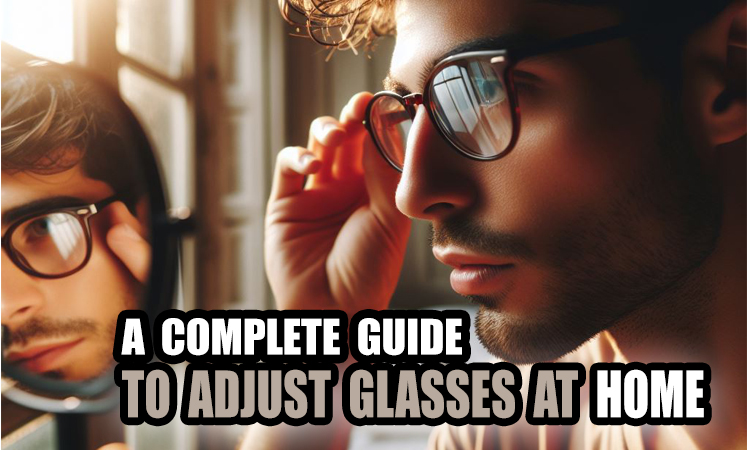
a complete guide to adjusting glasses at home
Wearing glasses is a standard solution for vision correction, but occasionally, they may require adjustments to ensure optimal comfort and functionality. While it’s advisable to seek professional help for significant adjustments, you can perform several minor tweaks at home to enhance the fit and feel of your eyeglasses. This guide will provide you with a clear and concise step-by-step process. You are adjusting glasses at home, promoting a snug fit and clear vision.
All things you will need to adjust your glasses:
1. Eyeglass repair kit (screwdriver, nose pads, screws)
2. Warm water
3. Microfiber cloth
4. Tweezers
5. Hairdryer (optional)
Step 1: Clean Your Glasses
Before you make any adjustments, please clean your glasses thoroughly using mild soap and warm water. This ensures accumulated dirt or oils won’t interfere with the adjustment process.
Step 2: Check for Loose Screws
Inspect your glasses for any loose screws. If you find any, use the screwdriver from your eyeglass repair kit to tighten them. Make sure not to overtighten, as this could lead to damage.
Step 3: Adjust the Temple Arms
You can adjust the temple arms if your glasses feel too tight or loose on your head’s sides. Gently bend the arms outward or inward to achieve the desired fit. Please be careful and make minor adjustments to avoid breakage.
Step 4: Modify the Nose Pads
Nose pads contribute significantly to the comfort of your glasses. If they are too tight or too loose, adjust them accordingly. Use tweezers to bend the nose pads carefully for a snug fit. If your glasses have silicone nose pads, warming them with a hairdryer for a few seconds can make the adjustment easier.
Step 5: Straighten Crooked Frames
If your glasses appear crooked on your face, carefully bend the frame until it sits straight. Hold the edge firmly with both hands and gently adjust until you get a balanced fit. Take your time to avoid overcorrection.
Step 6: Align Your Lenses
Ensure that your lenses are correctly aligned in the frame. If one lens appears higher or lower than the other, adjust them by gently pushing or pulling until they are symmetrical.
Step 7: Final Checks
Put on your glasses and assess the fit. Ensure they feel comfortable, sit evenly on your face, and provide clear vision. If needed, make additional adjustments until you are satisfied.
How can we find a proper way to adjust glasses at home?
Wearing glasses is not just about correcting vision; it’s also about comfort and a clear line of sight. The need for adjustments often arises as glasses settle into life’s daily wear and tear. While significant adjustments should be left to professionals, there are several ways to fine-tune the fit of your glasses at home, ensuring they stay snug and provide optimal vision. In this guide, we’ll explore the step-by-step process of finding the proper way to adjust glasses at home with precision.
Understanding the Basics of Glasses Adjustments:
Before diving into the adjustments, it’s crucial to understand the anatomy of your glasses. Most eyeglasses consist of temple arms, nose pads, and frames. Knowing how these components work together will help you identify areas needing tweaking.
Step 1: Assessing the Fit
Begin by wearing your glasses and assessing the fit. Note any discomfort, tightness, or uneven pressure on your face. This initial evaluation will help you figure out which areas may need adjustment.
Step 2: Checking for Loose Parts
Inspect your glasses for loose screws. A common cause of discomfort is a flexible hinge or temple screw. Use the screwdriver from your repair kit to tighten any loose screws gently. Ensure not to overtighten, as this may cause damage.
Step 3: Temple Arm Adjustment
If your glasses feel too tight or loose on your head’s sides, it’s time to adjust the temple arms. Hold the frame firmly and, using gentle pressure, bend the temple arms outward or inward to achieve a comfortable fit. Make minor adjustments and test the fit as you go.
Step 4: Tweaking Nose Pads
The nose pads play a crucial role in the overall comfort of your glasses. If they feel too tight or loose, use tweezers to bend them carefully for an optimal fit. If you have silicone nose pads, warming them with a hairdryer for a few seconds can make the adjustment easier.
Step 5: Straightening Crooked Frames
A crooked frame can cause discomfort and affect your vision. Hold the edge with both hands and, with gentle pressure, make minor adjustments until the glasses sit straight on your face.
Step 6: Lens Alignment
Check that your lenses are correctly aligned within the frame. If one lens appears higher or lower than the other, make slight adjustments by pushing or pulling gently until they are symmetrical.
Step 7: Final Evaluation
Put on your glasses and assess the fit one final time. Ensure they sit comfortably on your face, with even pressure and clear vision. Please make further adjustments until you reach the desired outcome. Comfort and functionality, if necessary.
What parts of glasses can be problematic while adjusting glasses?
Wearing glasses is a necessity for many, providing clear vision and comfort. However, as with any tool we use regularly, adjustments may be needed to maintain an optimal fit. Knowing which parts of your glasses may pose challenges during the adjustment process is critical to ensuring a seamless and practical experience. This article will explore the common problematic areas when adjusting glasses and provide insights into addressing these issues.
Temple Arms
Problem: Temple arms that are too tight or loose can cause discomfort and impact the overall fit of your glasses.
Solution: Gently bend the temple arms inward or outward to achieve the desired fit. Make minor adjustments, and test the fit regularly to avoid overcorrection.
Nose Pads
Problem: Ill-fitting nose pads can lead to pressure points, causing discomfort and leaving marks on the nose.
Solution: Use tweezers to adjust the nose pads carefully. If they are too tight, gently bend them outward; turn them inward if they are too loose. Applying heat (using a hairdryer) for silicone nose pads can make adjustments easier.
Frame Alignment:
Problem: A crooked or misaligned frame can affect your vision and cause discomfort.
Solution: Hold the frame with both hands and make minor adjustments to straighten it. Check the alignment regularly by looking in a mirror, ensuring the structure sits evenly on your face.
Loose Screws
Problem: Loose screws in the hinges or temple arms can lead to instability and discomfort.
Solution: Use a screwdriver from an eyeglass repair kit to tighten any loose screws gently. Be cautious not to overtighten, as this may cause damage.
Uneven Lens Height
Problem: Lenses that are not properly aligned can cause visual distortions and discomfort.
Solution: Adjust the height of the lenses by gently pushing or pulling them until they are symmetrical. Please check your vision regularly to make sure it’s clear.
Frame Material Sensitivity:
Problem: Some frames, especially those made of certain materials, may be more prone to breakage during adjustments.
Solution: Please be careful when adjusting frames made of delicate materials. If you need more clarification, please seek professional assistance to avoid accidental damage.
Persistent Discomfort:
Problem: Despite adjustments, persistent discomfort may indicate underlying issues that require professional attention.
Solution: If discomfort persists or worsens after adjustments, consult an optician or eyecare professional. They can identify any structural issues or recommend alternative solutions.
Is adjusting glasses a process based on the shape of our face?
The world of eyewear is not just about vision correction; it’s a blend of functionality and style. While selecting the right frame is essential, ensuring a perfect fit on your face is equally important. The adjustment process for glasses isn’t a one-size-fits-all scenario—rather, it can be a nuanced art that considers your face’s unique contours. In this article, we’ll explore whether adjusting glasses is a process influenced by the shape of our face and how understanding these dynamics can lead to a more comfortable and stylish eyewear experience. The Relationship Between Face Shape and Glasses Adjustment:
Our faces come in various shapes—oval, round, square, heart, and more. Each form has distinct features that influence how glasses sit and feel. Understanding your face shape can be instrumental in making personalized adjustments that enhance comfort and aesthetics.
Oval Faces:
Characteristics: Balanced proportions, slightly curved jawline, well-defined cheekbones.
Adjustment Focus: Maintain the natural balance by ensuring the glasses sit evenly on the nose and temples. Avoid overly tight or loose fits to preserve the harmonious proportions.
Round Faces:
Characteristics: Soft curves, a shorter forehead, and a rounded chin.
Adjustment Focus: Opt for angular frames to add definition. Please make sure the glasses sit higher on the bridge of the nose to elongate the appearance of the face.
Square Faces:
Characteristics: Strong jawline, forehead, and cheekbones with a more angular appearance.
Adjustment Focus: Soften the angles with round or oval frames. Adjustments should complement the robust features without accentuating sharpness.
Heart-Shaped Faces:
Characteristics: Broad forehead, narrow chin, and high cheekbones.
Adjustment Focus: Choose frames that balance the width of the forehead and bring attention downward. Adjustments should ensure a comfortable fit on the nose and temples.
Diamond Faces:
Characteristics: Narrow forehead and jawline, with wider cheekbones.
Adjustment Focus: Frames that highlight the eyes and balance the cheekbones work well. Please make sure the glasses sit comfortably without pinching at the temples. Adjustment Techniques for Different Face Shapes:
Temple Arm Adjustment:
Oval Faces: Maintain even pressure for balanced comfort.
Round Faces: Tilt the temple arms slightly upward for a lifting effect.
Square Faces: Ensure the temple arms follow the face’s natural angles.
Heart-shaped faces: A slight outward bend for comfort.
Nose Pad Adjustment:
Oval Faces: Keep nose pads at a moderate width for balance.
Round Faces: Opt for slightly wider nose pads to prevent slippage.
Square Faces: A medium nose pad width to complement angular features.
Heart-Shaped Faces: Adjust nose pads for a secure fit without putting excessive pressure on the nose.
Frame Tilt:
Oval Faces: Maintain a parallel frame position for symmetry.
Round Faces: Slight tilting can add definition.
Square Faces: Subtle tilting softens angular features.
Heart-Shaped Faces: A slight downward tilt for balance.
Conclusion
In conclusion, adjusting glasses at home is a nuanced process combining practicality, personalization, and a touch of artistry. Whether you’re tightening screws, tweaking temple arms, or modifying nose pads, the key lies in understanding the specific needs of your eyewear and your unique facial features. The comprehensive guide offers step-by-step insights into adjusting glasses, ensuring optimal comfort and functionality.
Certain areas of glasses can pose challenges during the adjustment process, and recognizing these potential pitfalls is crucial. From temple arms that need a delicate touch to nose pads requiring careful calibration, each adjustment contributes to your glasses’ overall comfort and fit.
Moreover, the relationship between face shape and glasses adjustment adds more sophistication. Whether your face shape is oval, round, square, heart, or diamond, it allows for adjustments that improve comfort and enhance the aesthetic appeal of your eyewear.
In the end, the art of precision in adjusting glasses involves:
- A blend of practical techniques.
- A keen awareness of potential issues.
- A personalized approach tailored to the unique contours of your face.
Whether making subtle tweaks for comfort or refining the fit for style, the goal is to create an eyewear experience that not only corrects your vision but also complements your individuality. So, the next time you adjust your glasses at home, remember that it’s not just a task—it’s an opportunity to embrace the art of personalization and make your eyewear uniquely yours.
FAQ
- Why do we need to adjust the glasses at home? Because it can be so quick and we do not want to spend lots of money because of minor issues.
- What is the best way to adjust the glasses on our faces? It would be related to the area you want to put glasses on, which can be crucial.
- Can adjusting be problematic for people? If we can use the content of this article, it will be accessible forever; the main idea is that you can change it by yourself.



